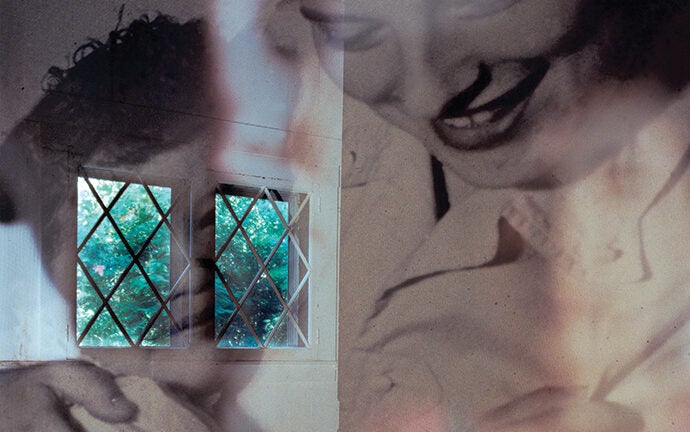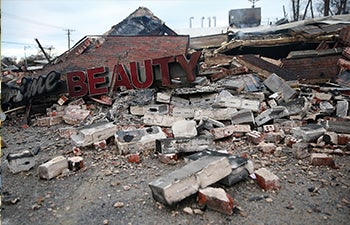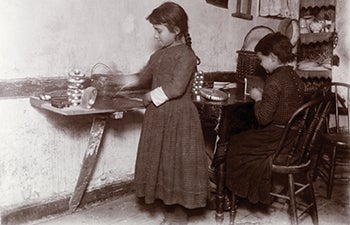
Through the Lens
Mirrored Images
By Geoff Dyer
Two related questions: How long do we have to go back to trace the origins of what happened last year in Ferguson, Mo.? And when does the aftermath of what happened begin?
In terms of narrative history, origins and aftermath — causes and effects — are continuous, capable of being lengthily extended in either direction so that “what happened” is the aftermath. While many strong photographs captured protests, unrest, rioting and the way the police provoked or responded to them, the BEAUTY picture by Justin Sullivan seems directly to engage with these questions.

Photo by Walker Evans. Image copyright The Metropolitan Museum of Art. Image Source: Art Resource, NY.
What it lacks in photojournalistic immediacy is more than compensated for — especially now, many months later — by its reach. (Since it was taken in Dellwood, Mo., that reach is geographical as well as historical.) Giventhe number of camera crews and press photographers camped out in Ferguson, waiting for the verdict on the killing of Michael Brown, hoping for photogenic action, it also serves the useful function of reminding us that there was a time when reported events went unphotographed.
In showing the aftermath of a demonstration, Sullivan harks back to a time when the machinery of photography was too cumbersome and slow to capture events as they occurred. Unable to record a cavalry charge in the Crimea, Roger Fenton famously photographed cannonballs lying in the Valley of Death in 1855. What was absent could only be suggested or implied by what was present. So it is here — except the implication is, so to speak, explicit.
Back in the 1960s, the phrase “Black Is Beautiful” was more than a slogan; it was part of a movement and force for change. During the Ferguson protests, the main message on placards was “Black Lives Matter,” which seemed a less radical, even humble claim — not a claim at all, in fact, so much as a reminder. In this photograph, all that remains of the militant 1960s assertion is “BEAUTY” — a plea rendered not just meaningless but visibly contradicted by the ruination of which it is part and to which it provides a wanly ironic caption.

Photo by Justin Sullivan/Getty Images.
The extent of the damage done is exacerbated by another aspect of the photograph’s reach. This is almost spelled out, since the damaged “BEAUTY” sign cannot but recall another self-captioning image, possibly the most famous one of all. In about 1929, Walker Evans (born, incidentally, in St. Louis) photographed workers loading a long, neon “DAMAGED” sign onto the back of a truck. The two signs are tilted at exactly the same angle (20 degrees, I’m guessing) but it is, of course, the differences that make the resemblance so effective.
The DAMAGED picture is anything but. On the contrary, it’s pristine and perfect — a thing of such obvious aesthetic beauty as to instantly label itself as an Evans, as an American Photograph! Sullivan’s is altogether less assured of its standing and status. Sure, it’s an impressive picture (that’s why we’re still looking at it, long after its retail value as a news picture has passed), but it lacks the capacity to assert and define — as Evans did, again and again — both the centrality of the medium and the photographer’s instantly eminent place in its history.
One might almost say that it stands amid the rubble of that tradition and history, in the long aftermath of the original.
Writer in residence Geoff Dyer’s book White Sands will be published in Spring 2016 by Pantheon.
Flash of Inspiration
By Kate Flint
In 1887, Jacob Riis was working as a journalist in New York City when a four-line newspaper item caught his eye: “There it was, the thing I had been looking for all those years … The darkest corner might be photographed that way.” Two German chemists had just invented flash powder.
For more than 30 years, until the invention of the flash bulb, this magnesium compound was essential to the taking of pictures in dark places.
For Riis, the literal associ-ations of illumination were infused with biblical overtones of revelation. He saw it as his mission to expose terrible living conditions in lodging houses and tenements, and the crowded sweatshops of Manhattan’s Lower East Side.
Sometimes his subjects stare out of the frame, angry at this interruption of light; sometimes they seem clearly posed. Sometimes, as in the image of “Little Susie,” they appear too busy with piecework to stop. Indeed, as she pastes linen on tin covers for pocket flasks, this 12-year-old works “with hands so deft and swift that even the flash could not catch her moving arm.”
Riis deliberately sought a compassionate response. He contextualized his subjects, making us see them as types — and often victims — rather than individuals.

Photo by Jacob A. Riis, courtesy of the Museum of the City of New York.
At the same time, we see not just his human subjects, but all the details of a room. Flash is a great democratizer. Light cannot be carefully directed, and this means that work tools, crockery and lace curtains often take on unplanned prominence as a sudden flare makes them more noticeable than at any other time in their existence. Were the room’s inhabitants aware that the picture was crooked? Does the flash reveal a material reality that is not, in fact, visible to those who inhabit dark interiors? Or, there’s another possibility: Did Riis himself tilt the frame, giving a compositional unity through this diagonal?
How far, in other words, can one trust the details given in a documentary picture, where a photographer may move an object to improve aesthetics or reinforce a polemical point?
In documentary photography, “reality” is not just found in physical surroundings — even if sparse, grimy furnishings exert a calculated appeal on the middle classes at whose political and charitable sensibilities these images were aimed. It’s located in human interactions and expressions, even when a photograph is clearly posed.
“Child With Cat and Two Women” by an anonymous photographer resides in the archives of the Community Service Society of New York. Almost certainly a flash device was used to take it; the shadows and reflections suggest that it was held high and off to the left.

Photo Courtesy of the CSS Photography Archives, Community Service Society of New York and the Rare Book and Manuscript Library, Columbia University.
But what is going on? Is this a visit to the woman’s home by a “friendly visitor,” as turn-of-the-century social workers were called? If so, why does the little girl wear outdoor clothes? Does her expression suggest mistrust of the photographer, or of the woman in a hat, or bewilderment at the whole set of circumstances? Is the younger woman sad to see her leave, or happy to have her home? Is she saying goodbye to the kitten? Does the array of pill bottles on the mantelshelf suggest that someone — mother, child, absent family member — is sick? Why the flag on the same mantelshelf? What of the mismatch — surely revealed by flash — between the untidy newspapers shoved into the grubby area behind the stove and the mess of papers on the table behind, and the china and trinkets that display a desire to decorate and beautify these shabby surroundings?
What does the image say about the intersection of human resilience and charitable intervention?
What happens next?
Reality is not readily captured. It’s a complex, messy thing — not just illuminated by a brilliant light and caught on a photographic plate. Photography may stop its flow for a moment, and even bring out and fix details that are not readily apparent in reality’s daily flow. But very often, the most provocative images are those that suggest tensions, stories, circumstances and inner lives that the camera can hint at, but never fully reveal.
Kate Flint is Provost Professor of Art History and English. She is currently completing her book Flash! Photography, Writing, and Surprising Illumination.
Read more stories from USC Dornsife Magazine‘s Fall 2015-Winter 2016 issue >>